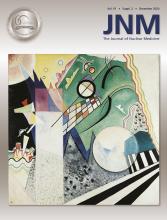Targeted radionuclide therapy has been progressing over decades, and although the approval of 177Lu-DOTATATE brought a new focus on targeted radionuclide therapies, it is the development of prostate-specific membrane antigen (PSMA)–targeted therapeutics that has brought the most attention to the field. The 2017 article by Kambiz Rahbar et al., entitled “German Multicenter Study Investigating 177Lu-PSMA-617 Radioligand Therapy in Advanced Prostate Cancer Patients,” was the splash that brought these treatments to the forefront (1). This article presented the largest collection of patients treated with 177Lu-PSMA-617 at the time and spawned enormous interest in PSMA-targeted therapy. It was originally published online in October 2016, and the first prospective study using this agent was not published until the article of Hofman et al. came out in May 2018 (2). During the intervening 18 months, Endocyte purchased the rights to 177Lu-PSMA-617 and the VISION trial was approved and opened. Without the results presented in the Rahbar article, this fast-paced progress in the field would never have been achieved.
The Rahbar article was a retrospective collection of patients treated under the compassionate-use program at 12 facilities in Germany. How compassionate-use authorization is used to support research is not uniformly implemented, although in the setting of 177Lu-PSMA-617, it is evident that access to this therapy benefits the patient and therefore is following the intention of the law. It is important for a moment to highlight some differences between compassionate use as it is implemented in Germany and the right-to-try law in the United States. With the right-to-try law, a therapeutic agent has to complete phase 1 studies, the manufacturer has to approve its use, and the patient has to have exhausted all available therapies (3). In Germany, compassionate use does not have these requirements and is frequently used to perform first-in-humans diagnostic and therapeutic studies. The intention of both compassionate use and right-to-try is identical: to provide therapeutic options to patients who have none.
Notwithstanding the limitations of the Rahbar article, the value of 177Lu-PSMA-617 was acknowledged by the Food and Drug Administration, as evidenced by its willingness to allow Endocyte to forgo conventional phase 1 and phase 2 trials before opening the phase 3 VISION study. That decision in most part was based on data such as that presented in the Rahbar article. This article paved the way for what will hopefully become a standard therapy for men with metastatic prostate cancer.
Although targeted radionuclide therapy has been around for decades in nuclear medicine, treatments such as 177Lu-PSMA-617 that were brought to the forefront by the Rahbar article are changing the face of nuclear medicine. The ability to radiolabel small molecules using α- and β-emitters is providing several therapeutic avenues for many cancers. The optimism, based on results such as found in the Rahbar article, has motivated research and investment in numerous new molecules. We as a field look forward to the future advancements in antibodies and small molecules that will help reshape nuclear medicine.
DISCLOSURE
No potential conflict of interest relevant to this article was reported.
- © 2020 by the Society of Nuclear Medicine and Molecular Imaging.
- Received for publication June 22, 2020.
- Accepted for publication June 26, 2020.







